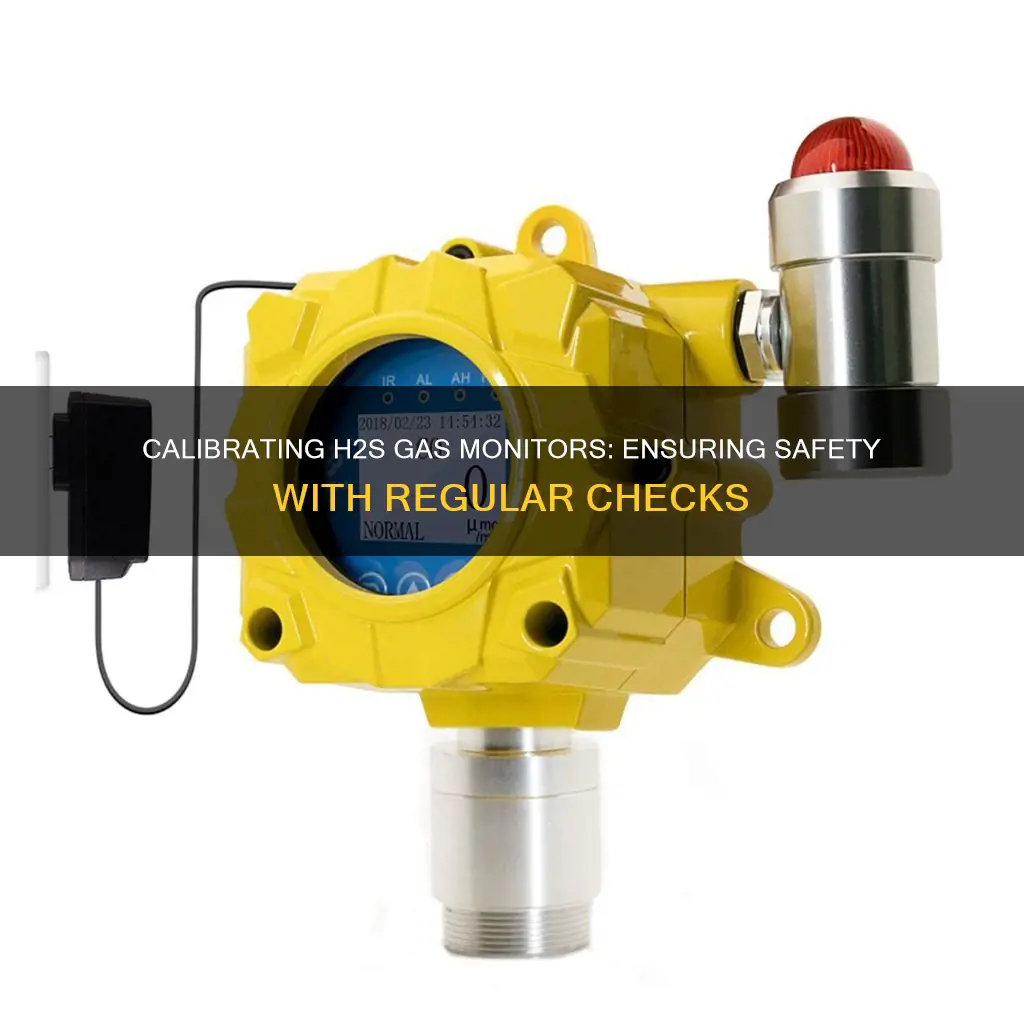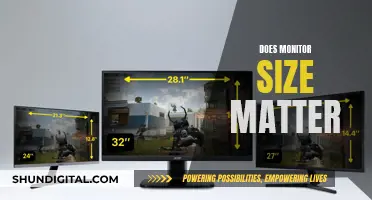
Calibration is important for gas detectors to ensure they are functioning properly and to prevent injury or death. The calibration frequency for gas detection instruments depends on how often the instrument is used and the conditions it is used in. For example, if a gas detector has been exposed to high gas concentrations or unusual conditions, it is recommended that a bump test or calibration be performed. Regulatory agencies such as OSHA typically refer users to follow the manufacturer's recommended protocols for calibration, but these guidelines can sometimes be unclear or inconsistent. In general, for most users, a calibration frequency of between one and six months is recommended, with some sources suggesting that calibration should be performed before each use.
| Characteristics | Values |
|---|---|
| How often should H2S gas monitors be calibrated? | It depends on the usage. If the readings are required to hold up in court as data for certain legal applications, they must be calibrated before and after each test or series of tests. If the instrument is only used a few times a year for non-critical applications, it should be calibrated before each use. |
| Bump testing | Bump testing should be performed before each use. If the monitor fails the bump test, it must be calibrated. |
| Calibration frequency | Calibration frequencies typically range from once a month to once every six months. Some manufacturers recommend calibrating every three to six months. |
| Calibration cost | Calibration costs around $85 in a lab, or you can purchase a calibration kit for around $425. |
What You'll Learn

Calibration drift
Several factors can contribute to calibration drift in H2S gas monitors:
Age
The gradual chemical degradation of sensors and drift in electronic components that occur naturally over time. Sensor degradation is when the sensors become less responsive, leading to inaccurate gas concentration readings.
Environment
Chronic exposure to extreme environmental conditions, such as high/low temperatures, humidity, and high levels of airborne particulates. Fluctuations in temperature, humidity, and pressure can influence the accuracy of gas detectors, leading to shifts in calibration.
Sensor Poisoning
Exposure to high concentrations of target gases and vapours can cause sensor poisoning. This can also include exposure to solvent vapours and highly corrosive gases.
Monitor Abuse
Harsh storage and operating conditions, such as dropping the instrument or submerging it in liquid. Normal handling and jostling of the equipment can create enough vibration or shock over time to affect the electronic components and circuitry.
To address calibration drift, routine calibration and maintenance are essential for H2S gas detectors. This includes regular calibration checks, sensor replacement, environmental monitoring, proper handling, and record-keeping. Calibration checks should be conducted at specified intervals, typically following manufacturer recommendations and industry standards.
Android Studio: Monitor Your Android App's Performance
You may want to see also

Bump testing
The Occupational Safety and Health Administration (OSHA) defines a bump test as:
> ...a qualitative function check in which a challenge gas is passed over the sensor(s) at a concentration and exposure time sufficient to activate all alarm settings.
In other words, bump testing verifies the performance of the gas detector and ensures that sensors are responding to their target gas. For example, an H2S sensor is exposed to H2S gas to verify it can detect the presence of the gas. A successful bump test will result in both an audible alarm and a visual confirmation on the display that the sensors have successfully responded to their respective gases.
It is important to note that bump testing is not the same as calibration. Bump testing does not check for accuracy; it only confirms that the sensors and alarms are working. To check for accuracy, calibration is required. However, bump testing can indicate when calibration is needed, often even before the manufacturer's recommendations. If a bump test fails, the device requires calibration.
There are different ways to perform bump testing, including manual tests and using docking stations. Manual bump tests can be done using a gas bottle, regulator, tubing, and a calibration cup. Docking stations, on the other hand, automate the process by drawing gas through a connected cylinder and applying it to the detector. They also offer additional benefits, such as charging and performing maintenance tasks on the detectors.
In conclusion, bump testing is a critical step in ensuring the functionality of gas detectors. By exposing the sensors to a concentration of gas, bump testing verifies that the detectors will respond to the presence of hazardous gases. While it does not replace calibration, bump testing is a simple and effective way to ensure the basic functionality of gas detectors before each use.
Removing Monitoring on Your Tascam: A Step-by-Step Guide
You may want to see also

Calibration frequency
The calibration frequency depends on how the instrument will be used. For instance, if the readings are required to hold up in court as data for legal applications, the instrument must be calibrated before and after each test or series of tests. On the other hand, someone who only uses the instrument a few times a year for non-critical applications should calibrate before each use.
RKI Instruments outlines two extremes of calibration frequency:
- Users requiring data for legal applications must calibrate before and after each test or series of tests to ensure the instrument is functioning properly.
- Infrequent users should calibrate their instrument before each use.
Most users fall somewhere between these two extremes. RKI suggests that typical calibration frequencies for standard applications range from three to six months but can vary depending on usage. Similarly, a1-cbiss, a service centre for gas detection equipment, recommends calibration at least every six months for reliable performance.
To summarise, the calibration frequency depends on the specific use case and the manufacturer's recommendations. However, it is generally recommended to calibrate at least every three to six months, with some sources suggesting more frequent calibration for certain applications.
Asus Monitor Power Cord Size: What You Need to Know
You may want to see also

Regulatory agencies' recommendations
Regulatory agencies typically refer users to follow the manufacturer's recommended protocols for calibration. The Occupational Safety and Health Administration (OSHA) recommends calibrating gas detectors before each use. However, they also acknowledge that this may not always be practical, especially for companies with a large number of monitors.
OSHA refers to the recommendations of the International Safety Equipment Association (ISEA), a trade association for manufacturers of protective equipment, which suggests verifying sensor accuracy before each day's use. This can be done through bump testing—exposing the instrument to a known concentration of test gas to ensure it registers—rather than a full calibration.
The ISEA recommends a full calibration when an instrument fails a bump test or after it has been serviced. They emphasize that calibration gas should always be certified by and traceable to the National Institute of Standards and Technology (NIST).
In practice, companies often develop their own intervals for bump testing and calibration based on their frequency of use and the gas concentrations their monitors are exposed to. For example, some companies that use their monitors infrequently, such as every 30 days or less, calibrate each time, while those that use them daily may calibrate less frequently but bump test more often.
The president of RKI Instruments, a gas monitor manufacturer, suggests that those who bump test before each use can extend the calibration cycle to "three to six months" if the instrument passes the bump test. Similarly, a1-cbiss, a service centre for gas detection equipment, recommends calibration at least every six months, with the possibility of extending the calibration cycle with a successful bump test.
For legal applications where readings must be incontrovertible, both OSHA and RKI Instruments state that calibration must be performed before and after each test or series of tests to ensure the proper functioning of the instrument.
Identifying Your Lenovo Monitor: A Step-by-Step Guide
You may want to see also

Manufacturer recommendations
The calibration frequency for a gas detection instrument depends on how often the customer will use it and for what purpose. For example, users who require the readings to hold up in court as data for certain legal applications must calibrate both before and after each test or each series of tests to ensure the proper functioning of the instrument. On the other hand, someone who only uses the instrument a couple of times a year for non-critical applications should calibrate their instrument before each use.
RKI Instruments outlines two extremes of calibration frequency. Firstly, users who require the readings to hold up in court as data for certain legal applications must calibrate both before and after each test or each series of tests. Secondly, someone who only uses the instrument a couple of times a year for non-critical applications should calibrate their instrument before each use.
Most users will be in the middle of these two extremes. RKI, for instance, concludes that "typical calibration frequencies for most applications are between 3 and 6 months, but can be required more or less often based on your usage". Similarly, a1-cbiss recommends that gas detection equipment is calibrated at least every six months for reliable performance. Honeywell BW recommends calibration at a minimum of every 6 months.
The calibration cycle can be extended for gas monitoring instruments that successfully pass the bump gas test prior to use. The president of RKI Instruments explains that folks who "bump test" before each use can extend the calibration cycle to "three to six months for instruments that successfully pass the bump gas test".
Some manufacturers provide an on-screen countdown. For example, the manufacturer of a 4-gas diffusion monitor provides an on-screen countdown of 180 days, explaining that the monitor does not need to be calibrated until then. The same company produces a single-gas monitor that is supposed to be self-calibrating and last for a full two years.
BW Honeywell recommends periodically testing the response of the hydrogen sulfide sensor to gas by exposing the detector to a target gas concentration that exceeds the low alarm setpoint, in other words, bump testing. However, BW Honeywell does not specify how often "periodically" is.
Understanding Performance Monitor Counters: A Beginner's Guide
You may want to see also
Frequently asked questions
The calibration frequency for H2S gas monitors depends on how often they are used and the conditions they are used in. Monitors that are used infrequently should be calibrated before each use. Monitors that are used frequently can be calibrated every 3-6 months, but this should be complemented with bump tests every couple of weeks.
Bump testing is the process of exposing the gas monitor to the target gas(es) to make sure they register. This is different from calibration, which involves adjusting the instrument's reading to coincide with a known concentration of test gas.
If your H2S gas monitor fails a bump test, you must perform a full calibration to make sure the sensors and the monitor are able to provide accurate readings and alerts.
Calibration drift occurs when the communication (electrical signal) between the sensor and the monitor changes from what it was at the time of its last calibration. This change is unavoidable and can be caused by age, exposure to extreme environmental conditions, sensor poisoning, or monitor abuse. Calibration is necessary to prevent calibration drift and ensure the accuracy of gas monitors, which can save lives.







